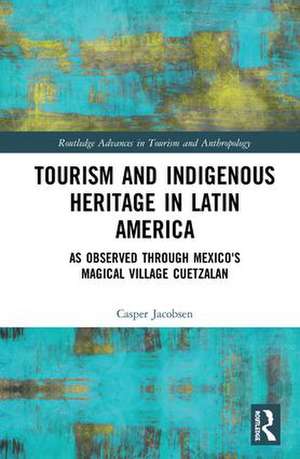Tourism and Indigenous Heritage in Latin America: As Observed through Mexico's Magical Village Cuetzalan: Routledge Advances in Tourism and Anthropology
Autor Casper Jacobsenen Limba Engleză Hardback – 20 aug 2018
By examining contemporary Mexican tourism policies and multiculturalist ideals through policy analysis and ethnographic research in a mestizo municipalcapital in a majority indigenous Nahua municipality, this book shows how mestizo nationalism is regenerated in tourism as part of a neoliberal governmentality framework. The book demonstrates how tourism initiatives that center on indigenous cultural heritage and recognition do not self-evidently empower indigenous citizens, and may pave the way for extracting indigenous heritage as a national resource to the benefit of local elites and tourist visitors.
This work is of key interest to researchers, advanced students, and critically engaged practitioners in the fields of Latin American studies, indigenous studies, social anthropology, critical heritage studies, and tourism.
| Toate formatele și edițiile | Preț | Express |
|---|---|---|
| Paperback (1) | 257.68 lei 43-57 zile | |
| Taylor & Francis – 30 iun 2020 | 257.68 lei 43-57 zile | |
| Hardback (1) | 763.89 lei 43-57 zile | |
| Taylor & Francis – 20 aug 2018 | 763.89 lei 43-57 zile |
Preț: 763.89 lei
Preț vechi: 1102.59 lei
-31% Nou
Puncte Express: 1146
Preț estimativ în valută:
146.22€ • 158.88$ • 122.90£
146.22€ • 158.88$ • 122.90£
Carte tipărită la comandă
Livrare economică 21 aprilie-05 mai
Preluare comenzi: 021 569.72.76
Specificații
ISBN-13: 9781138088252
ISBN-10: 1138088250
Pagini: 204
Ilustrații: 12 Halftones, black and white; 12 Illustrations, black and white
Dimensiuni: 156 x 234 x 18 mm
Greutate: 0.44 kg
Ediția:1
Editura: Taylor & Francis
Colecția Routledge
Seria Routledge Advances in Tourism and Anthropology
Locul publicării:Oxford, United Kingdom
ISBN-10: 1138088250
Pagini: 204
Ilustrații: 12 Halftones, black and white; 12 Illustrations, black and white
Dimensiuni: 156 x 234 x 18 mm
Greutate: 0.44 kg
Ediția:1
Editura: Taylor & Francis
Colecția Routledge
Seria Routledge Advances in Tourism and Anthropology
Locul publicării:Oxford, United Kingdom
Public țintă
Postgraduate and UndergraduateCuprins
Prologue: Hope and despair in Cuetzalan 1. Introduction 2. Governing frames 3. Working the translocal field 4. The diachronic Magical Villages Program. Frames and technologies in motion 5. When pros turn pro: Community ambassadors and social order 6. Multicultourism in the Magical Village: Setting temporality and translocality 7. Networking/rooting: Ritual co-parenthood in Tzinacapan 8. Regenerative fiesta: ritual configuration of history, identity, and society Epilogue
Notă biografică
Casper Jacobsen holds a PhD in American Indian Languages and Cultures, and is a postdoctoral fellow at the University of Copenhagen and the State University of New York at Albany, USA. His research focuses on the history and heritage of indigenous peoples in pre-Hispanic, colonial, and contemporary Latin America.
Recenzii
"Going beyond the sustainability and empowerment frameworks frequently employed in the tourism literature, Casper Jacobsen’s Tourism and indigenous heritage in Latin America: As observed through Mexico’s Magical Village Cuetzalan offers the reader a critical examination of the emergence of multicultourism, defined by the author as a neoliberal governmentality frame that fuses multicultural politics of recognition with tourism, while conceptualizing indigenous heritage as a ‘national resource’ to be exploited in tourism initiatives." - Laura Paola Vizcaino-Suárez, Journal of Heritage Tourism
"Although this book analyses a specific Mexican community, it offers crucial insights into the global politics of recognition in the name of tangible and intangible heritage, especially UNESCO’s World Heritage programme..Jacobsen’s discussion of his methodological approach in Chapter 3 includes a thoughtful description of his interview process and the challenges and benefits of doing field research while accompanied by family members. These sections would be especially helpful for early-career scholars preparing to embark on their own projects...It provides a concrete example of the perils of the politics of recognition for marginalized communities by revealing how the official embrace of Indigenous heritage can function as yet another form of dispossession, and is thus of interest to a broad range of scholars of tourism, heritage studies and Indigenous studies, and scholars of the politics of recognition in and beyond Latin America." Lisa Pinley Covert, Journal of Latin American Studies
"Although this book analyses a specific Mexican community, it offers crucial insights into the global politics of recognition in the name of tangible and intangible heritage, especially UNESCO’s World Heritage programme..Jacobsen’s discussion of his methodological approach in Chapter 3 includes a thoughtful description of his interview process and the challenges and benefits of doing field research while accompanied by family members. These sections would be especially helpful for early-career scholars preparing to embark on their own projects...It provides a concrete example of the perils of the politics of recognition for marginalized communities by revealing how the official embrace of Indigenous heritage can function as yet another form of dispossession, and is thus of interest to a broad range of scholars of tourism, heritage studies and Indigenous studies, and scholars of the politics of recognition in and beyond Latin America." Lisa Pinley Covert, Journal of Latin American Studies
Descriere
The book assesses current multiculturalist policies in Mexico and how they affect local indigenous populations. The book examines a state tourist initiative of "Magical Villages" where tourists can have special experiences linked to ideas of indigeneity, tradition and heritage. The argument is that this policy acts as a way to contain, constrain and regulate indigenous peoples and their imagined "cultures", in line with existing policies of indigenismo in Mexico. The book explores the mechanisms by which local elites and tourist visitors get empowered, while local indigenous people get disempowered or at least channelled into certain kinds of activities.










